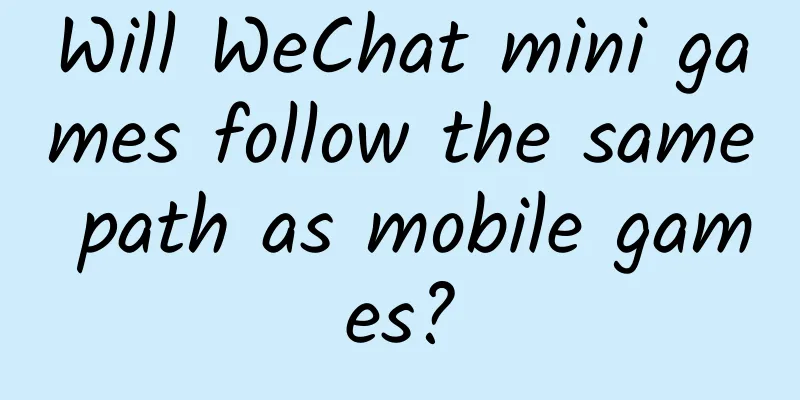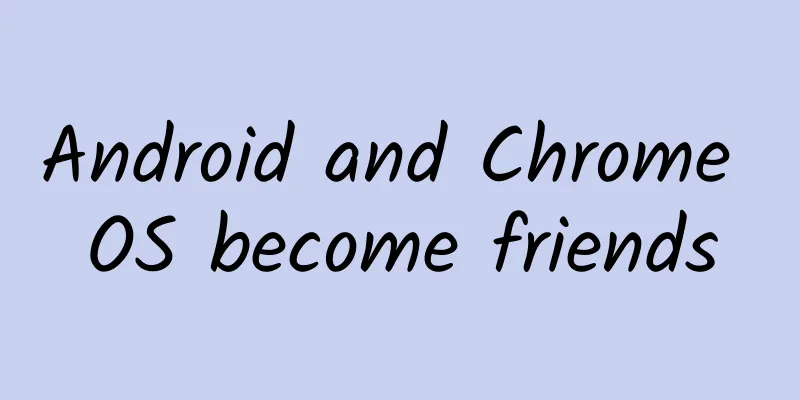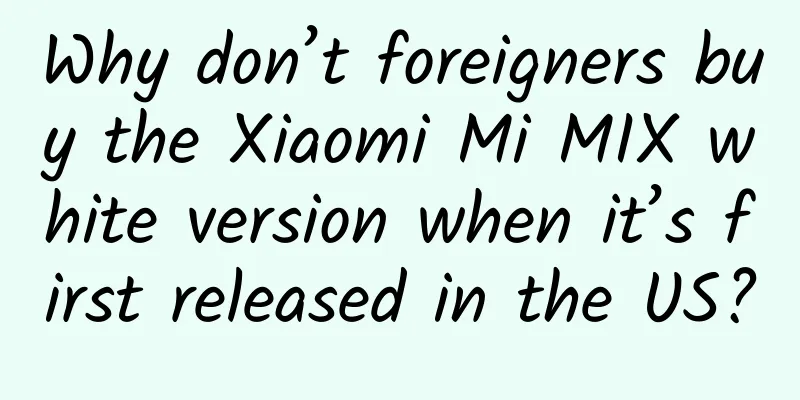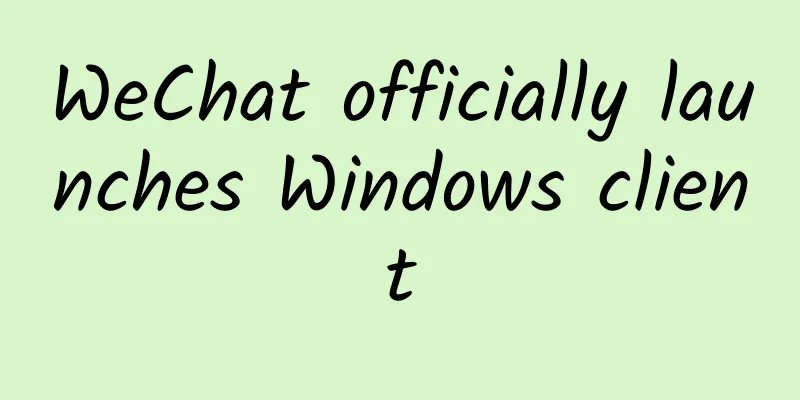Will WeChat mini games follow the same path as mobile games?

|
WeChat announced that the monthly revenue of several mini-games on Android devices exceeded 10 million; Aladdin held a mini-program innovation conference; Zhu Xiaohu's words "The bonus period of mini-programs is this year. If you miss it, you will completely lose this opportunity, and mini-games are the most promising area among them" once again pushed mini-games to the forefront. As Tencent further taps into the user traffic of WeChat, will the development of mini-games follow the old path of mobile games? Today’s mini-games are like the early days of mobile games. Whether it is the previous disclosure of WeChat Open Class or the TOP50 mini-program game list released by Aladdin, the emphasis on light leisure, puzzle, and competition through social sharing and dissemination is the current mainstream and the direction of future explosive products. The product types and forms of these games are exactly the same as when mobile games were first developed. There is no major innovation in terms of content and gameplay, but rather the old types are rehashed, such as Landlord, Tank Wars, and Jump Jump. In the mobile game industry, Ketchapp, which was acquired by Ubisoft, has been copying the casual game formula since 2048, using social platforms such as Facebook to share and spread the game, and once became the world's fourth largest mobile game publisher (download volume). In China, there is the case of Cheetah Mobile acting as the agent (and later acquiring) for the Don't Step on the White Tiles series. There is also a cycle in the acquisition and distribution of user traffic. The user ceiling of mobile games depends on the number of mobile users. As the demographic dividend disappears, the growth rate will naturally slow down. Mini games, on the other hand, are based on the secondary mining and distribution of Tencent WeChat user traffic and are now in a stage of rapid growth. In terms of social communication, mobile games can be shared through multiple social channels, while mini-games are limited to the internal ecosystem of super apps such as WeChat. This also means that the ceiling for mini-games is relatively lower, and the market is no longer dominated by the industry environment, but by the owners (channels) of super apps. Compared with the initial development environment of mobile games, small games are squeezed by existing mobile games on the one hand, and on the other hand, copying the gameplay routines of mobile games has greatly shortened their growth cycle. This is also one of the reasons why Zhu Xiaohu said that the bonus period is only this year. On April 26, the WeChat Mini Games team announced its report card: more than 300 mini games have been released, several mini games have achieved a total user base of over 100 million, and many mini games have generated monthly Android revenue of over 10 million. Will the development of mini-games in the future only focus on light leisure, puzzle, and competitive fields, or will they develop from light to heavy like mobile games? H5 game "reversal" Mini games are inseparable from H5 games. In general, compared with H5, mini games add WeChat social capabilities, file systems, tool chains and other functions, and remove some technical points that are not important to the game side (DOM, BOM, CSS, etc.). H5 games have actually been developed for several years. Ever since the hit game "Surround the Crazy Cat" in 2014, people have predicted that it would explode every year until the emergence of small games. In the past, H5 games, which survived in the cracks of mobile games, have always been in an awkward situation. Although they have transitioned to the emergence of some heavy products, many of the top products have a monthly turnover of over 10 million, and there is also the example of "Sword of the Archangel H5" with a monthly turnover of over 100 million, the total revenue of China's H5 game market in 2017 was less than 5 billion. Part of the reason is that the traffic cost and revenue of H5 games did not match each other before, and channels were more willing to give traffic resources to mobile games. In addition, heavy H5 games do not have strong social capabilities, and similar to web games, they generally rely on channels to guide traffic. WeChat has opened up the third mini-game market, which has led many H5 game practitioners to raise their market expectations to 30 billion in 2018. However, the embarrassing thing is that the restrictions on light leisure, puzzle and competitive categories have reversed from H5 games to mini-games. Zhang Xiaolong once said that mini programs are not to replace apps, but to enrich the application scenarios of apps. This also means that as long as the size limit of the package is not lifted (4M for the first package), the ability to charge for props will be greatly suppressed, because this is the part that heavy H5 games are good at. The ability to realize revenue will rely more on the advertising revenue of mini games, which can also be seen from the recent test of the WeChat team to open banner ads and incentive ads. And this business model is also a common routine for casual mobile games. Trial version is equal to interactive advertising At the 2018 WeChat Open Class PRO, the WeChat team shared several possibilities for mini-games: for large games with a capacity of more than 1G, mini-games can be used to create "trial versions" to lower the threshold, gain initial exposure, and cultivate fans; some in-game modules can also be split into mini-games (such as sign-in, card drawing, etc.) to maintain activity. (Note: Japan previously had a promotional gameplay called "flying gashapon", where cards can be drawn in advance during the game pre-registration stage.) These practices are actually using mini games to play the role of advertising traffic, which is consistent with the concept of "interactive advertising" that is becoming increasingly popular in the current mobile advertising field. That is, developers make the tutorial part of their own games into demos, allowing users to try them out directly when they see the ads, thereby increasing the conversion rate of ads. According to a survey report released by AdColony in 2017, 71% of advertisers believe that interactive ads are effective. Among the samples of this survey report, 75% of the respondents are game developers. Among the respondents, 45% of advertisers said that interactive ads are the form of advertising they are most interested in in 2017. Interactive ads under the mini-game template can be used in more areas than just games. Facebook has previously revealed that it is testing interactive ads. One of the test participants, Gram Games, said that interactive ads perform better than video ads in terms of user engagement and return on investment. In terms of return on ad spend (ROAS), the average interactive ad is 25% to 30% higher than video ads. Another test participant, Miniclip, said that interactive ads increased the click-through rate of ads by 3 times, reduced the average cost of app installation by 25%, and the return on advertising expenditure was twice that of regular video ads. Prior to this, Google had already begun to provide services to developers to help them create interactive ads. To put it bluntly, developers of mini games can even try to develop To B businesses in the future and diversify their services to advertisers. The next stage of development of mini games depends on the ability of developers to obtain traffic and play with advertising, and more importantly, it depends on whether the WeChat team allows mini games to continue to follow the development path of "from light to heavy" mobile games. |
<<: The love-hate relationship between development and testing
>>: How developers seek technical improvement in boring work
Recommend
WeChat is going crazy! Can public accounts also broadcast live? Is the era of WeChat bringing goods coming?
Recently, WeChat quietly updated a major function...
Investors tell you how fierce artificial intelligence will be in the next 3 to 5 years
Before Google Alpha Go played against Lee Sedol, ...
Satellite photography: What the Earth looks like from space
How about renting or buying a satellite to take p...
400 activation and charging standards, how much does it cost to activate a 400 phone number?
400 telephone numbers are not completely free num...
Heavy rain is coming! You should know these self-help knowledge
Since April, most of southern China has experienc...
Tesla's alternative "PUBG", players can enter the game to experience Model Y's autonomous driving
In the past few years, Tesla has been committed t...
Spring is here, and rhinitis is here! How to deal with annoying allergic rhinitis?
It is spring again, and it is the time to enjoy t...
Tencent, NetEase, Sohu, Toutiao, the current four major news and information apps competitive analysis
At present, there are many news clients on the ma...
Top command line tips from Linux experts
Speaking of fun, nothing beats sitting around the ...
Artificial Intelligence: Driving China's Economic Growth (Chinese version)
The report, titled "Artificial Intelligence:...
How did mammals rise? These animals living in China 125 million years ago were the key
From whales that live like fish in the ocean, to ...
Nokia is making mobile phones again: Can it stage a comeback?
Recently, after Nokia spent a lot of money to acq...
With comprehensive upgrades in intelligence, control and appearance, Trumpchi GS4 PLUS continues its series of million-dollar legends
With the popularity of family cars, SUVs have bec...
How many of these 10 tips for promoting mini programs do you know?
If you care about mini programs , then you should...









